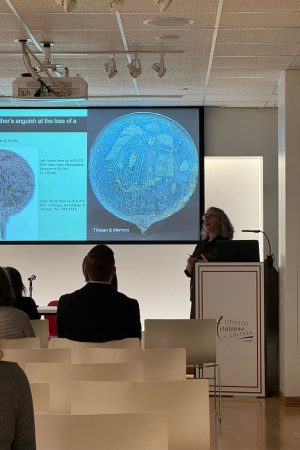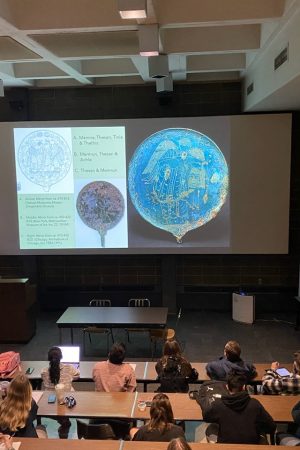 CCS Professor of Art History and Associate Dean of the College of Arts and Letters Dr. Alexandra Carpino gave an invited lecture titled “Marketing Motherhood: Etruscan Case Studies” at Northern Illinois University on Oct. 11 and at the Italian Cultural Institute of Chicago on October 12, 2023. She discussed how one class of household artifacts – engraved bronze mirrors – depict mothers in particular, in the fourth century BCE.
CCS Professor of Art History and Associate Dean of the College of Arts and Letters Dr. Alexandra Carpino gave an invited lecture titled “Marketing Motherhood: Etruscan Case Studies” at Northern Illinois University on Oct. 11 and at the Italian Cultural Institute of Chicago on October 12, 2023. She discussed how one class of household artifacts – engraved bronze mirrors – depict mothers in particular, in the fourth century BCE.
Marketing Motherhood: Etruscan Case Studies
Representations of mothers are everywhere in Etruscan art, testifying to the importance of the family and its visualization in funerary, religious, and domestic contexts. On one important class of household artifacts – engraved bronze mirrors – narratives featuring divine and mythical mothers enter the corpus in the fifth century BCE and remain present well into the early third century. Notably, the stories that most appealed to the mirrors’ principal users, women, were those highlighting the close bond between a mother and her son/s. Closely tied to this maternal ideal, especially in the fourth century BCE, are the phenomenon of undress, with a particular emphasis on the mother’s breasts and torso, and a visual rhetoric that appears, at least to modern eyes, to veer towards the erotic. What engravers were marketing, however, wasn’t anything untoward, discomforting, or explicitly sexual about mother-son relationships in Etruria – rather, their imagery presented potential customers with various exempla whose bodies and behaviors materialized the elite’s expectations for their womenfolk. Equally novel is the messaging manifested by a different maternal paradigm that engravers first include in the corpus in the fifth century, one that highlights mothers who are punished by their sons for behaving badly. All in all, whether uplifting or cautionary, the pictorial emphasis on mothers in Etruscan mirror iconography magnified the links between actions and gender norms in the domestic sphere.
